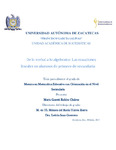
Please use this identifier to cite or link to this item:
http://ricaxcan.uaz.edu.mx/jspui/handle/20.500.11845/1209Full metadata record
| DC Field | Value | Language |
|---|---|---|
| dc.contributor | 490390 | es_ES |
| dc.contributor.advisor | Mónica del Rocío Torres Ibarra | es_ES |
| dc.contributor.author | Leticia Sosa Guerrero | es_ES |
| dc.coverage.spatial | Zacatecas, México | es_ES |
| dc.creator | Robles Chairez, Maria Goretti | - |
| dc.date.accessioned | 2019-10-11T17:51:23Z | - |
| dc.date.available | 2019-10-11T17:51:23Z | - |
| dc.date.issued | 2017-02-20 | - |
| dc.identifier | info:eu-repo/semantics/publishedVersion | es_ES |
| dc.identifier.uri | http://ricaxcan.uaz.edu.mx/jspui/handle/20.500.11845/1209 | - |
| dc.description | The present study details the adaptation, application and analysis of the results of a didactic sequence aimed at stimulating in first grade students the development of problem solving skills with linear equations of first degree, so that they opt for An algebraic approach. The didactic sequence was redesigned with Brousseau's Theory of Educational Situations (TSD) as a theoretical framework, where activities were proposed so that the student undergoes situations of action, formulation and validation, when solving problems involving linear equations. To carry out this work was used the methodology of Didactic Engineering. The objective of this work is that the students of the first high school see as an alternative solution algebraic approach to problems expressed verbally, to carry out the above, the sequence was first raised by a game. Regarding the results of the research, the students were able to find some algebraic approaches to solve the problem. From the above it is possible to be said that the students were able to give signs of using the algebra to pose problems that involve linear equations of first degree. | es_ES |
| dc.description.abstract | El presente trabajo de investigación detalla la adaptación, aplicación y análisis de resultados de una secuencia didáctica orientada a estimular en los estudiantes de primer grado de secundaria, el desarrollo de la capacidad de resolver problemas con ecuaciones lineales de primer grado, para que ellos opten por un planteamiento algebraico. La secuencia didáctica fue rediseñada teniendo como marco teórico la Teoría de Situaciones Didácticas (TSD) de Brousseau, donde se propusieron actividades de modo que el estudiante pase por situaciones de acción, formulación y validación, al resolver problemas que involucren ecuaciones lineales. Para llevar acabo este trabajo se utilizó la metodología de la Ingeniería Didáctica. El objetivo de este trabajo consiste en que los estudiantes de primero de secundaria vean como alternativa de solución el planteamiento algebraico a problemas expresados en forma verbal, para llevar acabo lo anterior, la secuencia se planteó primero mediante un juego. En cuento a los resultados arrojados por la investigación, los alumnos lograron encontrar algunos planteamientos algebraicos para la solución del problema. Por lo anterior se puede decir que los estudiantes lograron dar señales de utilizar el álgebra para plantear problemas que involucren ecuaciones lineales de primer grado. | es_ES |
| dc.language.iso | spa | es_ES |
| dc.publisher | Universidad Autónoma de Zacatecas | es_ES |
| dc.relation.isbasedon | Maestría en Matemática Educativa con Orientación en el Nivel Secundaria | es_ES |
| dc.relation.uri | generalPublic | es_ES |
| dc.rights | Atribución-NoComercial-CompartirIgual 3.0 Estados Unidos de América | * |
| dc.rights.uri | http://creativecommons.org/licenses/by-nc-sa/3.0/us/ | * |
| dc.subject.classification | HUMANIDADES Y CIENCIAS DE LA CONDUCTA [4] | es_ES |
| dc.subject.other | Secuencia Didáctica | es_ES |
| dc.subject.other | ecuaciones lineales | es_ES |
| dc.subject.other | incógnita, | es_ES |
| dc.subject.other | problemas verbales. | es_ES |
| dc.title | De lo verbal a lo algebraico: las ecuaciones lineales en alumnos de primero de secundaria | es_ES |
| dc.type | info:eu-repo/semantics/masterThesis | es_ES |
| Appears in Collections: | *Tesis*-- UA Matemáticas | |
Files in This Item:
| File | Description | Size | Format | |
|---|---|---|---|---|
| 2017 Robles, M.G..pdf | Tesis de Robles 2017 | 3,4 MB | Adobe PDF |  View/Open |
This item is licensed under a Creative Commons License
